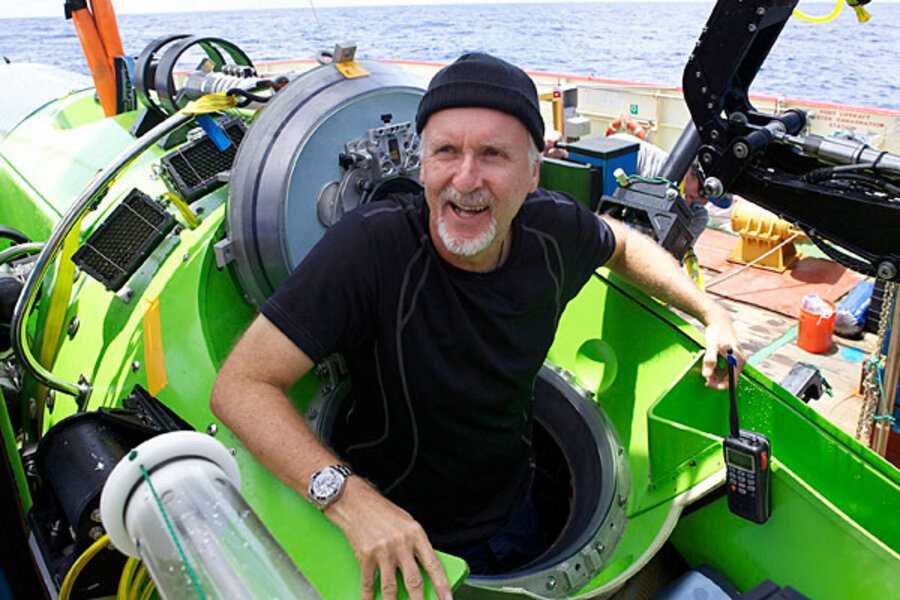Why James Cameron was forced to surface early
Loading...
"Titanic" film director James Cameron has completed the world's first solo dive to the deepest-known point on Earth, reaching the bottom of the Pacific Ocean's Mariana Trench southwest of Guam in a specially designed submarine.
Cameron planned to stay as long as six hours but a hydraulic leak forced the mission to be cut short.
"I lost hydraulics toward the latter part of dive, and I was unable to use the manipulator arm," Cameron said Monday morning during a post-dive press conference held aboard the Octopus, a yacht owned by Microsoft co-founder Paul Allen, according to National Geographic.
The filmmaker arrived at the site known as "Challenger Deep" shortly before 8 a.m. local time on Monday (6 p.m. Sunday E.T.), reaching a depth of 35,756 feet, or roughly 7 miles beneath the ocean's surface, said the National Geographic Society, which is overseeing the expedition.
IN PICTURES: the 20 weirdest fish
Cameron's first words to the surface on reaching the bottom following a descent that took two hours and 36 minutes were "All systems OK," National Geographic said on its website.
"Hitting bottom never felt so good. Can't wait to share what I'm seeing w/ you," the 57-year-old filmmaker said in a separate Twitter message posted just after he touched down.
The low point of the Mariana Trench, a great canyon below the Pacific, has been reached by humans just once before, in 1960 when U.S. Navy Lieutenant Don Walsh and the late Swiss oceanographer Jacques Piccard spent 20 minutes there in the submersible craft Trieste.
Cameron, the first person to make a solo dive to the spot, spent about three hours on the bottom collecting research samples for marine biology, geology and geophysics and taking still photographs and video footage of the trench.
After a faster-than-expected 70-minute return ascent, he safely reached the surface at noon local time Monday (10 p.m. Sunday ET) about 300 miles southwest of the U.S. territory of Guam in the western Pacific, National Geographic said in a press statement.
In a press conference Monday, Cameron described the bottom of the the trench as "very lunar, a very desolate place, very isolated.”
The expedition was a joint project by Cameron, National Geographic and watchmaker Rolex that has been dubbed "Deepsea Challenge" and was designed to expand understanding of a little-known corner of the Earth.
The Scripps Institution of Oceanography at the University of California, San Diego, is the project's principal science collaborator.
The single-man vehicle piloted by Cameron, the Deepsea Challenger, stands 24 feet tall and was designed to descend upright and rotating at a speed of about 500 feet per minute.
The submersible represents breakthroughs in materials science, structural engineering and imaging through an ultra-small, full-ocean depth-rated stereoscopic camera.
While he is perhaps better known as director of such films as "Titanic," "Avatar" and "Aliens," Cameron is no stranger to underwater exploration. For "Titanic," he took 12 dives to the famed shipwreck in the North Atlantic, leading him to develop deep-sea film and exploration technology.
He has since led six expeditions, authored a forensic study of the German battleship Bismarck wreck site and conducted extensive 3-D imaging of deep hydrothermal vents along the Mid-Atlantic Ridge, the East Pacific Rise and the Sea of Cortez.
The Deepsea Challenge expedition was chronicled for a 3-D feature film set for theatrical release and for subsequent broadcast on the National Geographic Channel.
Scripps oceanographer Lisa Levin said the project's potential for generating public interest in deep-ocean science was as important as any new species that Cameron might have discovered.
"I consider Cameron to be doing for the trenches what (French undersea explorer) Jacques Cousteau did for the ocean many decades ago," she told the National Geographic Daily News website.
(Editing by David Bailey and Peter Cooney)





